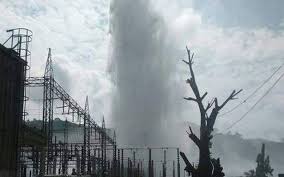by Mubina Akhtar
Four men were killed when the pipe that brings water from Kopili dam in the Indian state of Assam to its 275 MW hydropower station burst in the early hours of October 7. Three of them – J Sing Timung, Robert Baite and Prem Pal Balmiki – were employees of North Eastern Electric Power Corporation Limited (NEEPCO), a government-owned firm that operates the project. The fourth victim – still unidentified – worked for a contractor to the project. Hemanta Deka, NEEPCO executive director (Operations and Management), blamed rathole coal mining in Meghalaya for the accident.
Located on the southern bank of the Brahmaputra river that flows through the Assam valley, the Kopili dam is on the river with the same name. The Kopili river flows down to the Brahmaputra from the Meghalaya plateau in the south – and is now infamous for carrying coal slurry and acids used in rathole mining in Meghalaya. This practice, of creating narrow holes of about a metre in diameter in which only one person can enter, has been banned by the National Green Tribunal, India’s top green court, but continues illegally.
Deka says the acids from the slurry had corroded the pipe that was designed to bring water at the rate of 12,000 litres per second. The burst pipe caused a fountain that rose several hundred feet and continued to do so for hours, according to eyewitnesses. The four victims were washed away and their bodies could not be recovered for days. NEEPCO sought help from the National Disaster Response Force (NDRF) and the paramilitary Assam Rifles. It opened all gates of the dam to reduce the water flow to the powerhouse.
The incident showed a lack of emergency preparedness. “What is this? Why have no steps been taken for rescue by the government agencies?” asked the brother of Robert Baite, one of the four victims.
Kopili hydroelectric project was NEEPCO’s first project when the company was formed in 1976. It has two dams, on the Kopili River and on its tributary the Umrang River. The first power unit was commissioned in March 1984 and a second in July 2004. The powerhouse was renovated in the financial year 2015-16. A water tunnel that had cracked was repaired in 2018. The issue of corroded pipes remained unresolved.
No funds for maintenance
The Congress party that is in opposition in Assam and the centre has blamed the Bharatiya Janata Party-led central government for not releasing the money – INR 2 billion (USD 28 million) – for maintenance work in the project, though this had been approved by a Congress-led government before the party went out of power in 2014.
Making the allegation, Congress Member of Parliament from Assam Gaurav Gogoi also decried the centre’s reported move to merge NEEPCO with other government-run firms. “NEEPCO was established under the North East Council not only to tap the hydropower potential of the region but also to ensure overall socio-economic development,” he pointed out in a letter to the power ministry.
Durga Das Boro, spokesman of the Assam Pradesh Congress Committee, echoed Gogoi’s charge and said, “A major repair of the project was due in 2014. The life of the pipeline expired in 2014. However, it [the maintenance] could not be done as the BJP-led government had not released the amount approved.”
Acid-laced water
V.K. Singh, the head of NEEPCO, also blamed acidic water for corrosion of the water pipe and therefore the accident, while holding that the pipe that burst had been repaired just a year ago. He estimated the loss at INR 6 billion (USD 84 million).
NEEPCO officials say that since 2007, they have been warning the Central, Assam and Meghalaya governments about the acid-laced water, but no one listened to them.
Kopili and its tributaries – Kharkor, Myntriang, Dinar, Longsom, Amring, Umrong, Longku and Langkri – are known to be heavily affected by rathole mining for coal that is rampant in Meghalaya, especially in the Jaintia Hills in the eastern part of the state. The rivers run reddish due to a phenomenon called Acid Mine Drainage (AMD), caused by active and abandoned mines, coal storage sites and overburdened rocks. Leaching of heavy metals and the washing down of the soil removed to reach the coal seams add to the pollution in the rivers.
India’s National Green Tribunal (NGT) banned rathole mining in the Jaintia Hills and two other mining regions on April 17, 2014. “We are of the considered view that such illegal and unscientific method can never be allowed in the interest of maintaining ecological balance of the country and safety of the employees,” said the tribunal.
But the ban was opposed on the plea that the area is inhabited by indigenous communities that have special rights under India’s Constitution. The mining continues, and the miners continue to use child labour, again citing special rights. There has been no environmental impact assessment that was supposed to be mandatory under a 2006 notification, nor has the environmental clearance for mining activities – required under the 1986 Environment Protection Act – ever been given.
On January 4, 2019, the NGT fined the Meghalaya state government INR 1 billion (USD 14 million) for its failure to curb rathole mining. But India’s Supreme Court revoked the ban and allowed coal mining “on privately and community owned lands with permission from concerned authorities”.
NEEPCO’s responsibility
Most independent experts agree that pipes at the Kopili project have been affected by acidic water. But knowing this, why has NEEPCO continued to operate the dam and the power station, they ask.
The accident has brought back the debate on dam safety in north-eastern India, a region in which 168 hydropower projects are being planned – although it is unclear if many of them will see the light of day. Environmentalists have repeatedly questioned these plans, pointing out the adverse impacts on ecosystem and the risks to people. There have been a number of instances of floods being worsened because dam managers upstream have opened the gates.
NEEPCO has been in focus after a number of dam-induced accidents in its projects in the recent past. Assam’s Chief Minister Sarbananda Sonowal had to warn NEEPCO not to release water from its Ranganadi project while downstream areas were flooded anyway. There have been reports that the Kameng dam it is now building has already shown several leaks.
Along with rathole mining and NEEPCO, the entire issue of building dams in the geologically and ecologically fragile Himalayas is now being questioned again.
( The report first published in The Third Pole,, London)


